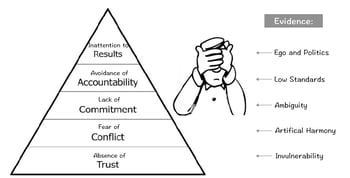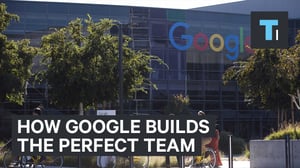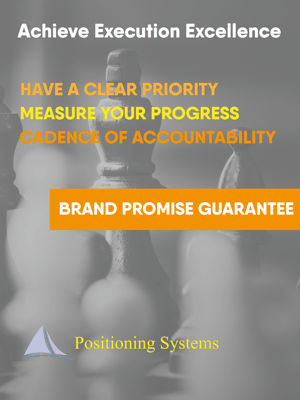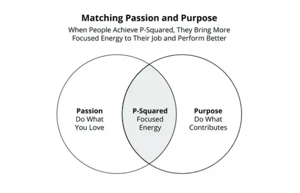 How do you measure your leadership team’s success?
How do you measure your leadership team’s success?
Patrick Lencioni, in The Five Dysfunctions of a Team, believes the ultimate measure of a team is their ability to consistently achieve the results they set.
Lencioni believes, in this day of informational ubiquity and nanosecond change, teamwork remains the one sustainable competitive advantage that is largely untapped.
How is your leadership team doing based on this scale of achievement?
Watch this 4 minute video on the Five Dysfunctions of a Team.
What’s Your Organizations Success Rate?
In October, one of my customers' Leadership team attended the Denver ScaleUp Summit. Immediately following I facilitated The Five Dysfunctions of a Team exercises. I’d recommended this in November of 2015 when we started working together.
Last week, at our Annual Strategy & Planning Meeting in Phoenix, one of the team members shared, “I feel when we look back at the work we accomplished on the Five Dysfunctions we’ll see how powerful it was in helping us reach our goals! To me it was a breakthrough and a turning point for our leadership team!”
Another team member who reluctantly participated, became the biggest advocate, leading the group to commit in developing the theme. He followed up, sharing the notes he’d taken on everyone’s commitments to improve their strengths, over come their weaknesses, to limit these from inhibiting the teams’ performance.
.jpg?width=352&name=BE-CI%20Thematic%20Goal%20(5%20Dysfunctions%20of%20Team).jpg) This is my customer’s 5 Dysfunctions of A Team theme. Every leadership meeting, our Annual Planning meeting begins with reviewing these commitments.
This is my customer’s 5 Dysfunctions of A Team theme. Every leadership meeting, our Annual Planning meeting begins with reviewing these commitments.
They agreed to commit to this theme for 2019!
 In coaching ScaleUp customers, Verne Harnish’s rule for a leadership team is to hit 75% of the objectives they set on their quarterly and annual plans. Verne believes this should ensure growth to stay ahead of your competitors. Goals should neither be slam dunks, nor insurmountable challenges. They should be SMART goals. (Specific, Measurable, Achievable, Relevant, Time-Bound)
In coaching ScaleUp customers, Verne Harnish’s rule for a leadership team is to hit 75% of the objectives they set on their quarterly and annual plans. Verne believes this should ensure growth to stay ahead of your competitors. Goals should neither be slam dunks, nor insurmountable challenges. They should be SMART goals. (Specific, Measurable, Achievable, Relevant, Time-Bound)
We shared this theme in What Are You Exactly Saying Yes To.
Having completed the 5 Dysfunctions Exercises, I believe my customer success rate will consistently surpass the 75% mark. Conflicts still exit in personalities, the difference is, these conflicts and personality differences are transparent. Each team member is committed to work through their challenges, recognizing theirs and others leadership strengths that contribute to the team. Egos are gradually being eliminated for the success of the team.
Their commitment to 2019 One Thing shares this confidence.
As a reminder here is a description of the Five Dysfunctions.
My team worked through these 5 exercises through one day together.
5 Dysfunctions of a Team Outdated?
Patrick Lencioni’s 5 Dysfunctions of a Team appeared in 2002. Changes in business and leadership have occurred since then.
 A recently published article in the NY Times, What Google Learned From Its Quest to Build the Perfect Team, suggests Lencioni’s principles are not only on track, but are a reliable platform to build a winning team.
A recently published article in the NY Times, What Google Learned From Its Quest to Build the Perfect Team, suggests Lencioni’s principles are not only on track, but are a reliable platform to build a winning team.
Collaboration, and teamwork today is even more valuable and critical to success than ever before. “If a company wants to outstrip its competitors, it needs to influence not only how people work but also how they work together.”
“One study, published in The Harvard Business Review last month, found that ‘the time spent by managers and employees in collaborative activities has ballooned by 50 percent or more’ over the last two decades and that, at many companies, more than three-quarters of an employee’s day is spent communicating with colleagues.
Leading and working inside a team is increasing! In Great At Work, Morten Hansen shares, “Organizations are “flatter” and less hierarchical. As a result, employees and managers must interact more across departments and work more in teams, including teams composed of members from different departments.
That changes the skills you need to succeed in your job. In an IBM study, two-thirds of CEOs regarded collaboration and communication as ‘key drivers of employee success to operate in a more complex, interconnected environment.’”
Great at Work: How Top Performers Do Less, Work Better, and Achieve More discovered in analyzing data, top performers mastered working with others in three areas: advocacy, teamwork, and collaboration. We’ll explore these in a future blog.
WHERE TO START
Interested in improving your team’s ability to achieve results?
Read Lencioni’s 5 Dysfunctions of a Team. You and your team can take the assessment on line for $49/team member. If you’re interested in applying Strategic Discipline and the ScaleUp principles to your business, as well as completing the 5 Dysfunctions of a Team exercise, contact me directly dwick@positioningsystems.com.
 Growth demands Strategic Discipline.
Growth demands Strategic Discipline.
Positioning Systems is obsessively driven to improve your business and your teams execution. 3 Strategic Disciplines: Priority, Metrics and Meeting Rhythms help your business dramatically improve your forecasting, individual and team performance to create alignment. It empowers your team to achieve accelerated growth.
As an Execution Decision, Strategic Discipline increases your Profitability.
Positioning Systems helps your business achieve these outcomes on the Four most Important Decisions your business faces:
|
DECISION |
RESULT/OUTCOME |
|
PEOPLE |
|
|
STRATEGY |
|
|
EXECUTION |
|
|
CASH |
|
We help your business achieve Execution Excellence.
Positioning Systems helps mid-sized ($5M - $250M) business Scale-UP. We align your business to focus on Your One Thing! To achieve growth, you need to evolve in today’s rapidly changing economic environment. Have you been avoiding a conversation on how you can successfully grow your business? Contact dwick@positioningsystems.com to Scale Up your business! Take our Four Decisions Needs Assessment to discover how your business measures against other Scaled Up companies. We’ll contact you.
 NEXT BLOG – Connect Passion & Purpose
NEXT BLOG – Connect Passion & Purpose
To be Great at Work, author Morten Hansen, in his Denver ScaleUp Summit presentation, shared how leaders and employees combine passion and purpose. What is passion and purpose, and how can you combine these in your work to perform better? We’ll share how to create this “focused energy” next blog.






.jpeg?width=150&height=135&name=Hand%20with%20marker%20writing%20the%20question%20Whats%20Next_%20(1).jpeg)

